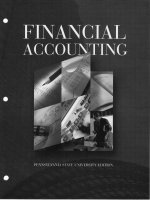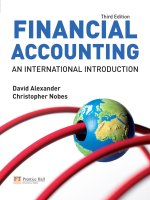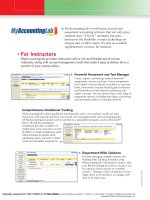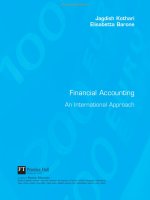Ebook Financial accounting (4E) Part 1
Bạn đang xem bản rút gọn của tài liệu. Xem và tải ngay bản đầy đủ của tài liệu tại đây (2.28 MB, 253 trang )
www.downloadslide.com
Financial Accounting is the ideal book for anyone with little prior knowledge or new to this subject area. Its clear
writing style and unique international focus builds on the success of the previous editions by teaching financial
accounting in a way that is not country-specific. This fully updated text uses the International Financial Reporting
Standards (IFRS) as its framework to explain key concepts and practices while linking them with contemporary and
real-world examples from Europe and beyond.
For further study visit Financial Accounting’s excellent companion website for additional questions and international
accountancy web links at www.pearsoned.co.uk/alexander. Answers to exercises are available to lecturers on the
instructor’s resource page.
David Alexander is Professor of Accounting at the University of Birmingham Business School, England.
Christopher Nobes is Professor of Accounting at Royal Holloway, University of London, England. From 1993 to 2001
he was a member of the board of the International Accounting Standards Committee.
Front cover image: © Getty Images
CVR_ALEX1642_04_SE_CVR.indd 1
Fourth Edition
FINANCIAL ACCOUNTING
AN INTERNATIONAL INTRODUCTION
David Alexander
Christopher Nobes
Fourth
Edition
Alexander & Nobes
Features
• IFRS abbreviations and a glossary of terms used in IFRS (and in UK and US accounting) are listed in an
accessible way.
• ‘Activities’ and ‘Why it Matters’ boxes are integrated throughout each chapter in order to challenge
students and encourage further study.
• Extensive exercises at the close of each chapter allow students to check their learning. Answers to
some exercises can be found in Appendix D.
• Separate appendices on double entry book-keeping, the requirements of IFRS and the EU fourth
directive allow students to tailor the book to their individual study needs.
• The book is fully updated to include changes of the past three years.
• Updated real-life examples from a wide range of countries give this text a truly international
perspective.
• The text is ideal for undergraduates and MBA students worldwide, taking a first course in financial
accounting.
FINANCIAL ACCOUNTING
Christopher Coles, Department of Accounting and Finance, University of Glasgow
AN INTERNATIONAL INTRODUCTION
‘This book will be welcomed by students and academics alike. The text is easy to read
and well laid out, the case studies are very helpful, and it is supplemented by a good
range of quality supporting material’
www.pearson-books.com
23/3/10 09:52:40
A01_FINA1642_04_SE_FM.qxd
3/10/10
10:10
Page i
www.downloadslide.com
FINANCIAL ACCOUNTING
An International Introduction
Visit the Financial Accounting: An International Introduction, fourth
edition Companion Website at www.pearsoned.co.uk/alexander
to find valuable student learning material including:
n
n
..
Self-assessment questions to check your understanding
Weblinks to relevant Internet resources to facilitate in-depth
independent research
A01_FINA1642_04_SE_FM.qxd
3/10/10
10:10
Page ii
www.downloadslide.com
We work with leading authors to develop the strongest
educational materials in accounting, bringing cutting-edge
thinking and best learning practice to a global market.
Under a range of well-known imprints, including
Financial Times Prentice Hall, we craft high-quality print
and electronic publications which help readers to
understand and apply their content, whether studying
or at work.
To find out more about the complete range of our
publishing, please visit us on the World Wide Web at:
www.pearsoned.co.uk
..
A01_FINA1642_04_SE_FM.qxd
3/10/10
10:10
Page iii
www.downloadslide.com
Fourth edition
FINANCIAL ACCOUNTING
An International Introduction
David Alexander and
Christopher Nobes
with an Appendix on Double-entry Bookkeeping
by Anne Ullathorne
..
A01_FINA1642_04_SE_FM.qxd
3/10/10
10:10
Page iv
www.downloadslide.com
Pearson Education Limited
Edinburgh Gate
Harlow
Essex CM20 2JE
England
and Associated Companies throughout the world
Visit us on the World Wide Web at:
www.pearsoned.co.uk
First published 2001
Second edition published 2004
Third edition published 2007
Fourth edition published 2010
© Pearson Education Limited 2001, 2010
The rights of David Alexander and Christopher Nobes to be identified as authors of this work
have been asserted by them in accordance with the Copyright, Designs and Patents Act 1988.
All rights reserved. No part of this publication may be reproduced, stored in a retrieval system,
or transmitted in any form or by any means, electronic, mechanical, photocopying, recording
or otherwise, without either the prior written permission of the publisher or a licence permitting
restricted copying in the United Kingdom issued by the Copyright Licensing Agency Ltd,
Saffron House, 6–10 Kirby Street, London EC1N 8TS.
All trademarks used herein are the property of their respective owners. The use of any trademark
in this text does not vest in the author or publisher any trademark ownership rights in such
trademarks, nor does the use of such trademarks imply any affiliation with or endorsement of
this book by such owners.
Pearson Education is not responsible for the content of third party internet sites.
ISBN: 978-0-273-72164-2
British Library Cataloguing-in-Publication Data
A catalogue record for this book is available from the British Library
Library of Congress Cataloging-in-Publication Data
Alexander, David, 1941–
Financial accounting : an international introduction / David Alexander and Christopher Nobes ;
with an appendix on double-entry bookkeeping by Anne Ullathorne. – 4th ed.
p. cm.
ISBN 978-0-273-72164-2 (pbk.)
1. International business enterprises–Finance. 2. Accounting. 3. Financial statements. I. Nobes,
Christopher. II. Title.
HF5686.I56A427 2010
657–dc22
2010004228
10 9 8 7 6 5 4 3 2 1
14 13 12 11 10
Typeset in 9.5/12.5pt Stone Serif by 35
Printed and bound by Ashford Colour Press, Gosport
The publisher’s policy is to use paper manufactured from sustainable forests.
..
A01_FINA1642_04_SE_FM.qxd
3/10/10
10:10
Page v
www.downloadslide.com
Contents
Foreword to the first edition
Preface
Acknowledgements
Abbreviations
1
Part 1 THE CONTEXT OF ACCOUNTING
1
Introduction
3
Objectives
3
1.1
1.2
1.3
1.4
1.5
2
3
xi
xiii
xv
xvi
Purposes and users of accounting
Accounting regulation and the accountancy profession
Language
Excitement in accounting
The path ahead
4
7
9
10
10
Summary
Exercises
11
11
Some fundamentals
13
Objectives
13
2.1
2.2
2.3
2.4
2.5
14
14
21
27
29
Introduction
The balance sheet
The income statement
Two simple equations
How cash flows fit in
Summary
Exercises
30
30
Frameworks and concepts
34
Objectives
34
3.1
3.2
3.3
3.4
3.5
35
37
38
42
44
Introduction
Underlying concepts
The IASB’s concepts
A hierarchy of concepts and some inconsistencies
Possible future developments
Summary
References and research
Exercises
44
45
45
v
..
A01_FINA1642_04_SE_FM.qxd
3/10/10
10:10
Page vi
www.downloadslide.com
Contents
4
5
The regulation of accounting
47
Objectives
47
4.1
4.2
4.3
4.4
4.5
48
48
50
53
58
Summary
References and research
Exercises
59
59
60
International differences and harmonization
61
Objectives
61
5.1
5.2
5.3
5.4
5.5
6
Introduction: various ways to regulate accounting
Legal systems
Entities
Examples of regulation
The regulation of International Standards
Introduction: the international nature of the development
of accounting
Classification
Influences on differences
Harmonization in the European Union
The International Accounting Standards Board
Summary
References and research
Exercises
89
90
91
The contents of financial statements
93
Objectives
6.1
6.2
6.3
6.4
6.5
6.6
6.7
7
62
63
70
80
85
Introduction
Balance sheets (statements of financial position)
Comprehensive income
Statements of changes in equity
Cash flow statements
Notes to the financial statements
Other general disclosure requirements
93
94
95
101
108
108
110
110
Summary
References and research
Exercises
113
114
114
Financial statement analysis
115
Objectives
115
7.1
7.2
7.3
7.4
7.5
7.6
116
116
119
122
129
130
Introduction
Ratios and percentages
Profit ratios
Profitability ratios
Liquidity ratios
Interest cover
vi
..
A01_FINA1642_04_SE_FM.qxd
3/10/10
10:10
Page vii
www.downloadslide.com
Contents
7.7
7.8
7.9
8
9
Funds’ management ratios
Introduction to investment ratios
Some general issues
131
133
135
Summary
Exercises
136
137
Part 2 FINANCIAL REPORTING ISSUES
143
Recognition and measurement of the elements
of financial statements
145
Objectives
145
8.1
8.2
8.3
8.4
146
146
148
157
Introduction
Primacy of definitions
Hierarchy of decisions
Income recognition
Summary
References and research
Exercises
160
161
161
Tangible and intangible fixed assets
162
Objectives
162
9.1
9.2
9.3
9.4
9.5
9.6
9.7
9.8
163
164
165
167
170
182
185
188
Preamble: a tale of two companies
Introduction
The recognition of assets
Should leased assets be recognized?
Depreciation of cost
Impairment
Measurement based on revaluation
Investment properties
Summary
References and research
Exercises
10 Inventories
189
190
190
193
Objectives
193
10.1
10.2
10.3
10.4
10.5
10.6
10.7
10.8
194
196
197
198
203
204
204
206
Introduction
Counting inventory
Valuation of inventory at historical cost
Inventory flow
Other cost methods
Valuation of inventory using output values
Practice
Current replacement cost
vii
..
A01_FINA1642_04_SE_FM.qxd
3/10/10
10:10
Page viii
www.downloadslide.com
Contents
10.9 Construction contracts
10.10 Construction contracts in practice
206
209
Summary
References and research
Exercises
211
211
211
11 Financial assets, liabilities and equity
214
Objectives
214
11.1
11.2
11.3
11.4
11.5
11.6
11.7
215
215
218
221
226
229
232
Introduction
Cash and receivables
Investments
Liabilities
Equity
Reserves and provisions
Comparisons of debt and equity
Summary
References and research
Exercises
233
234
234
12 Accounting and taxation
235
Objectives
235
12.1
12.2
12.3
12.4
236
238
240
241
Introduction
International differences in the determination of taxable income
Tax rates and tax expense
Deferred tax
Summary
References and research
Exercises
13 Cash flow statements
247
247
248
249
Objectives
249
13.1
13.2
13.3
13.4
13.5
250
251
253
254
260
Introduction
An outline of the IAS 7 approach
Reporting cash flows from operating activities
The preparation of cash flow statements
A real example
Summary
References and research
Exercises
14 Group accounting
260
260
262
263
Objectives
263
14.1 Introduction: the group
14.2 Investments related to the group
264
267
viii
..
A01_FINA1642_04_SE_FM.qxd
3/10/10
10:10
Page ix
www.downloadslide.com
14.3
14.4
14.5
14.6
14.7
Accounting for the group
Uniting of interests
Proportional consolidation
The equity method
Conclusion on group relationships
Summary
References and research
Exercises
15 Foreign currency translation
270
279
280
281
283
284
284
285
288
Objectives
288
15.1
15.2
15.3
15.4
289
289
292
294
Introduction
Transactions
Translation of financial statements
A numerical illustration
Summary
References and research
Exercises
16 Accounting for price changes
295
296
296
298
Objectives
298
16.1
16.2
16.3
16.4
16.5
16.6
16.7
16.8
16.9
299
299
305
305
310
312
316
319
320
Introduction
Effects of price changes on accounting
European disagreement
General or specific adjustment
General price-level adjusted systems
Current value accounting
Mixed values – deprival value
Partial adjustments
Fair values
Summary
References and research
Exercises
321
322
322
Part 3 ANALYSIS
327
17 Financial appraisal
329
Objectives
329
17.1
17.2
17.3
17.4
330
330
336
339
Introduction
More on investment ratios
Interpreting the balance sheet
Valuation through expectations
ix
..
A01_FINA1642_04_SE_FM.qxd
3/10/10
10:10
Page x
www.downloadslide.com
Contents
17.5 Valuation through market values
17.6 Accounting policies and financial appraisal
340
341
Summary
References and research
Exercises
349
349
350
18 International analysis
354
Objectives
354
18.1
18.2
18.3
18.4
18.5
18.6
355
355
359
360
361
361
Introduction
Language
Differences in financial culture
Accounting differences
Help by multinationals
Increasing international harmonization
Summary
References and research
Exercises
Annex: GlaxoSmithKline plc: Note on reconciliation from IFRS to US GAAP
365
365
366
367
Appendices
373
375
A Double-entry bookkeeping
B An outline of the content of International Financial
Reporting Standards
C An outline of the content of the EU’s Fourth Directive
on Company Law (as amended in 2001, 2003, etc.)
D Feedback on exercises
431
433
Glossary of terms
Index
451
469
420
x
..
A01_FINA1642_04_SE_FM.qxd
3/10/10
10:10
Page xi
www.downloadslide.com
Foreword to the first edition
For many years Professor Christopher Nobes and I have worked together as the
two British representatives on the Board of the International Accounting Standards
Committee. He and I have argued in many fora for the notion that there should be
one single set of high quality worldwide standards so that a transaction occurring
in Stuttgart, Sheffield, Seattle or Sydney should be treated in exactly the same way.
That is not the case at present.
In a book recently published by Professor Christopher Nobes and David Cairns,
‘The Convergence Handbook’, they outlined the existing differences between
British and International Accounting Standards. The intention of the book and
the request by the UK’s Accounting Standards Board for its production was to
eliminate these differences. It is particularly important this should be done over
the next five years as the European Commission has stated its intention that
all consolidated statements of Listed Companies in the European Union should
comply with International Accounting Standards by 2005. Clearly British Standards
will have to change, although as British Standards themselves are of high quality
it is very likely that some International Standards will also change.
To meet this challenge and to ensure that all countries have the same accounting standards, the International Accounting Standards Committee has been
reconstituted with effect from 2001 to form a virtually full-time International
Accounting Standards Board whose main mission is to seek convergence of
accounting standards throughout the world.
This book by my friends, David Alexander and Christopher Nobes, is therefore particularly timely. It is based on a background in the European Union. It is
written extremely clearly. (The real mark of a teacher is not to complicate but to
simplify and the authors have certainly done that.) It is unusual in that it takes as
its base not one country’s standards but International Accounting Standards, which
I firmly believe are going to be the worldwide requirements of the future.
The book will be of interest not only to the beginner but to those who wish to
understand the thrust of International Accounting Standards. The authors make
clear that accounting is still in many ways a primitive subject and is in a period
of change, removing the most irrelevant aspects of the historical cost model and
replacing them with accounting for fair values. Those coming into accounting now
are going to see huge changes in the first few years of their careers as many of the
ideas promulgated by academics many years ago become professional practice
and as each country’s national standards are changed to converge with the international consensus.
I enjoyed reading this book and I am sure that its many readers will also. I
congratulate the authors for their foresight in producing such an excellent book
and wish them well.
SIR DAVID TWEEDIE
January 2001
Chairman, International Accounting Standards Board
xi
..
A01_FINA1642_04_SE_FM.qxd
3/10/10
10:10
Page xii
www.downloadslide.com
Supporting resources
Visit www.pearsoned.co.uk/alexander to find valuable online resources
Companion Website for students
n Self-assessment questions to check your understanding
n Weblinks to relevant Internet resources to facilitate in-depth independent
research
For instructors
Complete, downloadable Instructor’s Manual
n PowerPoint slides that can be downloaded and used for presentations
n
Also: The Companion Website provides the following features:
n
n
n
Search tool to help locate specific items of content
E-mail results and profile tools to send results of quizzes to instructors
Online help and support to assist with website usage and troubleshooting
For more information please contact your local Pearson Education sales
representative or visit www.pearsoned.co.uk/alexander
..
A01_FINA1642_04_SE_FM.qxd
3/10/10
10:10
Page xiii
www.downloadslide.com
Preface
This is the fourth edition of our book that is designed as an introductory text in
financial accounting. What sets it apart from many other books with that basic
aim is that this book is not set in any one national context. Consequently, instead
of references to national laws, standards or practices, the main reference point is
International Financial Reporting Standards (IFRS).
Nevertheless, real entities operate in real countries even where they follow IFRS,
and so such entities also operate within national laws, tax systems, financial
cultures, etc. One of the backgrounds chosen in this book is the European Union
(EU) and the wider European Economic Area (EEA). Where useful, we refer to
the rules or practices of particular European countries or companies. However,
we also take examples from elsewhere, e.g. Australia.
This book is intended for those with little or no previous knowledge of
financial accounting. It might be particularly appropriate for the following types
of financial accounting courses taught in English at the undergraduate or postgraduate (e.g. MBA) level:
n
n
n
n
courses in any country in the EU (or EEA), given the increasing use of IFRS by
companies including the compulsory use for listed companies’ consolidated
statements;
courses outside the EU where IFRS are a relevant reference point, e.g. in Australia,
New Zealand, Singapore and other parts of the (British) Commonwealth;
courses in China or other countries where standards have been converged with
IFRS;
courses anywhere in the world with a mixture of students from several different
countries.
Depending on the objectives of teachers and students, stress (or lack of it) might
be placed on particular parts of this book. For example, it would be possible to
precede or accompany a course based on this book with an extensive examination
of double-entry bookkeeping, such that Appendix A is unnecessary. Or, on some
courses, there might not be space or appetite for coverage of issues such as foreign
currency translation (Chapter 15) or accounting for price changes (Chapter 16).
This edition is updated for the extensive changes of the three years since writing
the third edition. In writing this book we have, of course, made use of our experience over many years of writing and teaching in an international context. Thus, in
some places we have adapted and updated material that we have used elsewhere
in more specialist books to which the intended readers of this text would not
have easy access. We have tried to remove British biases, but we may not have
been fully successful and we apologize to readers who can still detect some.
There are four appendices, which we hope readers will find useful during and
after a course based on this book. Appendix A is a substantial treatment of doubleentry bookkeeping. Appendices B and C summarize the requirements of IFRS and
xiii
..
A01_FINA1642_04_SE_FM.qxd
3/10/10
10:10
Page xiv
www.downloadslide.com
Preface
the EU Fourth Directive respectively. Appendix D provides outline feedback to the
first two of each chapter’s closing exercises. Feedback on the other exercises is
given in an Instructor’s Manual that is available electronically via the Companion
Website at www.pearsoned.co.uk/alexander. The manual also contains other
material to assist lecturers. This book ends with a glossary and an index.
In preparing the first edition, we were greatly assisted by comments from
an apparently tireless team of reviewers, listed immediately hereafter. Certain
reviewers have commented further this time. We are also grateful for much help
from colleagues at Pearson. Despite all this help, there may be errors and omissions
in our book, and for this we must be debited (in your books).
DAVID ALEXANDER
University of Birmingham
CHRISTOPHER NOBES
Royal Holloway, University of London
Reviewers
This book has benefited very much from the advice and critical evaluation of
the following reviewers, whose comments throughout the preparation of various
editions are greatly appreciated:
Simon Pallett – University of Newcastle
Jim Hanly – Dublin Institute of Technology
Noreen Dawes – London Metropolitan University
Fredrik Ljungdahl – Jönköping International Business School
Deborah Lewis – Swansea University
Robert Major – University of Portsmouth
xiv
..
A01_FINA1642_04_SE_FM.qxd
3/10/10
10:10
Page xv
www.downloadslide.com
Acknowledgements
We are grateful to the following for permission to reproduce copyright material:
Figures
Figure 5.2 adapted from A judgemental international classification of financial
reporting practices, Journal of Business Finance and Accounting, Spring (Nobes, C.
1983); Figure 5.3 adapted from Towards a general model of the reasons for international differences in financial reporting, Abacus, Vol. 34, No. 2 (Nobes, C. 1998);
Figures 6.1, 6.2, 12.1, 13.6 adapted from Bayer Annual Report 2008; Figures 7.5, 8.7
adapted from Marks and Spencer plc Annual Report 2009; Figure 8.5 from CEPSA
Consolidated Statement of Income for the Year Ended 31 December 1998; Figures 18.1,
18.2 from GlaxoSmithKline plc Annual Report 2005.
Tables
Table 4.2 adapted from Plan Comptable Général (Conseil National de la
Comptabilité); Table 5.2 from The Accounting Review (Nair and Frank 1980) ©
American Accounting Association; Table 5.14 adapted from University of Reading
Discussion Papers in Accounting, Finance and Banking (Zambon, S. and Dick, W.
1998) No. 58; Tables 9.8, 10.13 adapted from European Survey of Published Accounts
1991, Routledge (FEE 1991); Table 14.6 adapted from extracts from published company financial statements, reproduced with the kind permission of Astrazeneca
UK Ltd; Table 18.1 adapted from BT Group plc Annual Reports 1999 and 2008;
Table 18.2 from Comparative International Accounting, Financial Times Prentice
Hall (S.J. McLeay in C.W. Nobes and R.H. Parker (eds) 2008) Chapter 18; Table
18.3 after Norsk Hydro Annual Reports, 1991, 1993, 2005.
Text
Extracts on pages 148, 180, 218, 291 from BASF published parent financial statements and Annual Report of BASF 2008; extract on page 186 from ING 2008
statements; extract on page 341 from Bayer Annual Report 2005; Chapter 18
Annex from GlaxoSmithKline plc Annual Report 2005.
In some instances we have been unable to trace the owners of copyright material, and we would appreciate any information that would enable us to do so.
xv
..
A01_FINA1642_04_SE_FM.qxd
3/10/10
10:10
Page xvi
www.downloadslide.com
Abbreviations
ABC
activity-based costing
AE
anonymos etairia (public company, Greece – transliteration of
Greek equivalent)
AG
Aktiengesellschaft (public company, Austria, Germany and
Switzerland)
AktG
Aktiengesetz (German Stock Corporation Law)
AMF
Autorité des Marchés Financiers (France)
ApS
anspartsselskab (private company, Denmark)
ARC
Accounting Regulatory Committee (EU)
AS
aktieselskab (public company, Denmark)
aksjeselskap (private company, Norway)
ASA
almennaksjeselskap (public company, Norway)
ASB
Accounting Standards Board (UK)
BV
besloten vennootschap (private company, Belgium and the
Netherlands)
CESR
Committee of European Securities Regulators
COB
Commission des Opérations de Bourse (former Commission for Stock
Exchange Operations, France)
CoCoA
continuously contemporary accounting
CONSOB
Commissione Nazionale per le Società e la Borsa (National Commission
for Companies and the Stock Exchange, Italy)
CPP
current purchasing power
CRC
current replacement cost
CV
current value
DCF
discounted cash flow
DRSC
Deutches Rechnungslegungs Standards Committee (German Regulatory
Standards Committee)
DV
deprival value
EBIT
earnings before interest and tax
EEA
European Economic Area
EFRAG
European Financial Reporting Advisory Group
EPE
etairia periorismenis efthynis (private company, Greece –
transliteration of Greek equivalent)
EPS
earnings per share
xvi
..
A01_FINA1642_04_SE_FM.qxd
3/10/10
10:10
Page xvii
www.downloadslide.com
Abbreviations
EU
European Union
EV
economic value
FAR
Föreningen Auktorisade Revisorer (a national accountancy body,
Sweden)
FASB
Financial Accounting Standards Board (USA)
FIFO
first in, first out
FRRP
Financial Reporting Review Panel (UK)
GAAP
generally accepted accounting principles
GmbH
Gesellschaft mit beschränker Haftung (private company, Austria,
Germany and Switzerland)
GPLA
general price level adjusted
HC
historical cost
HGB
Handelsgesetzbuch (Commercial Code, Germany)
IAS
International Accounting Standard
IASB
International Accounting Standards Board
IASC
International Accounting Standards Committee
IASCF
International Accounting Standards Committee Foundation
IFAC
International Federation of Accountants
IFRIC
International Financial Reporting Interpretations Committee
IFRS
International Financial Reporting Standard(s)
IOSCO
International Organization of Securities Commissions
JV
joint venture
Lda
sociedade por quotas (private company, Portugal)
LIFO
last in, first out
Ltd
private limited company (United Kingdom)
NBV
net book value
NRV
net realizable value
NV
naamloze vennootschap (public company, Belgium and the
Netherlands)
NYSE
New York Stock Exchange
OCI
other comprehensive income
Oy
Osakeyhtiö-yksityinen (private company, Finland)
Oyj
Osakeyhtiö julkinen (public company, Finland)
PE
price/earnings
PCG
plan comptable général (general accounting plan, France)
plc
public limited company (United Kingdom)
PPE
property, plant and equipment
RC
replacement cost
xvii
..
A01_FINA1642_04_SE_FM.qxd
3/10/10
10:10
Page xviii
www.downloadslide.com
Abbreviations
RJ
Raad voor de Jaarverslaggeving (Council for Annual Reporting, the
Netherlands)
ROCE
return on capital employed
ROE
return on equity
ROOE
return on ordinary owners’ equity
SA
sociedade anónima (public company, Portugal)
sociedad anónima (public company, Spain)
société anonyme (public company, Belgium, France and Luxembourg)
Sarl
société à responsabilité limitée (private limited company, Belgium,
France and Luxembourg)
SEC
Securities and Exchange Commission (USA)
SIC
Standing Interpretations Committee (former IASC body)
SMEs
small and medium-sized entities
SOX
Sarbanes–Oxley Act (USA)
STRGL
statement of total recognized gains and losses
SpA
società per azioni (public company, Italy)
SRL
società à responsabilità limitata (private company, Italy)
sociedad de responsabilidad limitada (private company, Spain)
SRS
Svenska Revisorssamfundet (a Swedish accountancy body)
TFV
true and fair view
UK
United Kingdom
US
United States
xviii
..
M01_FINA1642_04_SE_C01.qxd
3/9/10
10:16
Page 1
www.downloadslide.com
Part 1
THE CONTEXT OF ACCOUNTING
..
1
Introduction
2
Some fundamentals
3
Frameworks and concepts
4
The regulation of accounting
5
International differences and harmonization
6
The contents of financial statements
7
Financial statement analysis
M01_FINA1642_04_SE_C01.qxd
3/9/10
10:16
Page 2
www.downloadslide.com
..
M01_FINA1642_04_SE_C01.qxd
3/9/10
10:16
Page 3
www.downloadslide.com
Chapter 1
Introduction
Contents
Objectives
1.1
1.2
1.3
1.4
1.5
Purposes and users of accounting
Accounting regulation and the accountancy profession
Language
Excitement in accounting
The path ahead
Summary
Exercises
4
7
9
10
10
11
11
After studying this chapter carefully, you should be able to:
n
explain the scope and uses of accounting;
n
outline the role of national and international regulators;
n
give some examples of the usages of accounting terms in different varieties
of English.
3
..
M01_FINA1642_04_SE_C01.qxd
3/9/10
10:16
Page 4
www.downloadslide.com
Chapter 1 · Introduction
1.1 Purposes and users of accounting
There is no single authoritative and generally accepted definition of financial
accounting, or of accounting in general. Accounting began as a practical activity
in response to perceived needs, and for most of its development it has progressed
in the same way, adapting to meet changes in the demands made on it. Where
the needs differed in different countries or environments, accounting tended to
develop in different ways as a response to a particular environment, essentially
on the Darwinian principle: useful accounting survived. Because accounting
developed in different ways, it is likely that definitions suggested in different
surroundings will vary.
At a general level, accounting exists to provide a service. In the box below
there are three definitions. These have all been taken from the same economic and
cultural source (the United States) because that country has the longest history of
attempting explicit definitions of this type. Note that each suggested definition
seems broader than the previous one, and the third one does not restrict accounting to financially quantifiable information. Many would not accept this last
point. As will be explored in this book, attitudes to accounting and its role differ
substantially around the world and certainly between European countries.
Some definitions of accounting
Accounting is the art of recording, classifying and summarizing in a significant manner
and in terms of money, transactions and events which are, in part at least, of a financial
character, and interpreting the results thereof.
‘Review and Resume’, Accounting Terminology Bulletin No. 1 (New York: American Institute of
Certified Public Accountants, 1953), paragraph 5.
Accounting is the process of identifying, measuring and communicating economic
information to permit informed judgements and decisions by users of the information.
American Accounting Association, A Statement of Basic Accounting Theory (Evanston, IL: American
Accounting Association, 1966), p.1.
Accounting is a service activity. Its function is to provide quantitative information,
primarily financial in nature, about economic entities that is intended to be useful in
making economic decisions, in making resolved choices among alternative courses of
action.
Accounting Principles Board, Statement No. 4, ‘Basic Concepts and Accounting Principles Underlying
Financial Statements or Business Enterprises’ (New York: American Institute of Certified Public
Accountants, 1970), paragraph 40.
If information is to be useful, then some obvious questions arise: useful to
whom and for what purposes? A number of different types of people are likely
to be dealing with business entities:
1. Managers. These are the people who have to take decisions, both day-to-day and
strategically, about how the scarce resources within their control are to be used.
They need information that will enable them to predict the likely outcomes of
alternative courses of action. As part of this process, they need feedback on
4
..
M01_FINA1642_04_SE_C01.qxd
3/9/10
10:16
Page 5
www.downloadslide.com
1.1 Purposes and users of accounting
2.
3.
4.
5.
6.
7.
8.
the results of their previous decisions in order to extend successful aspects
of the decisions, and to adapt and improve the unsuccessful aspects.
Investors. A large entity may have many investors who are not the managers
of the entity. Some investors are owners (the shareholders); others provide
long-term debt capital. These providers of capital are concerned with the risk
inherent in, and return provided by, their investments. They need to determine whether they should buy, hold or sell their investments. Shareholders
are also interested in information to assess the ability of the entity to pay them
a return (known as a dividend). Potential investors have similar interests.
Other lenders. Lenders (such as banks) are interested in whether loans, and the
interest attaching to them, will be paid when due.
Employees. Employees and their representative groups are interested in the
profitability of their employers. They also want to assess the ability of the
entity to continue to provide remuneration, retirement benefits and employment opportunities.
Suppliers. These want to be able to assess whether amounts owing will be paid
when due. Suppliers are likely to be interested in an entity over a shorter period
than lenders, unless they depend upon the entity as a major continuing customer.
Customers. Customers need information about the continuance of an entity,
especially when they have a long-term involvement with the entity.
Governments. Governments and their agencies need information in order to
regulate the activities of entities and to collect taxation, and as the basis for
national income and similar statistics.
Public. Entities affect members of the public in a variety of ways; for example,
entities pollute the atmosphere or despoil the countryside. Accounting statements (generally called ‘financial statements’) may give the public information
about the trends and recent developments of the entity and the range of its
activities.
This list leads to a very important distinction, namely that between management
accounting and financial accounting. Management accounting is that branch of
accounting concerned with the provision of information intended to be useful to
management within the business. Financial accounting is the branch of accounting intended for users outside the business itself, i.e. groups 2–8 above. The above
descriptions of these groups is closely based on a document called Framework
for the Preparation and Presentation of Financial Statements of the International
Accounting Standards Board (IASB), discussed further in Chapter 3.
It is clear from the previous paragraphs that the needs of users to whom financial
accounting is addressed are very diverse, and so the same information will not
necessarily be valid for all their purposes. Nevertheless, it is usually assumed that
one set of financial statements in the public domain should be able to satisfy
most needs. The IASB Framework (paragraph 10) goes on to assert that:
While all of the information needs of these users cannot be met by financial statements, there are needs which are common to all users. As investors are providers
of risk capital to the enterprise, the provision of financial statements that meet
their needs will also meet most of the needs of other users that financial statements
can satisfy.
5
..
M01_FINA1642_04_SE_C01.qxd
3/9/10
10:16
Page 6
www.downloadslide.com
Chapter 1 · Introduction
This last sentence would earn a fail mark on any course in logic or philosophy,
but the view is widely followed in practice; that is, financial reporting is seen by
the IASB as largely designed to supply investors with useful information. Accepting, however, that the needs of different users are likely to be different and that
different users may predominate in different countries, it is clear that different
national environments (cultural, political and economic) are likely to lead to
different accounting practices. Indeed, financial reporting to various users (as
opposed to the mere recording of transactions, which is known as bookkeeping)
reflects the biases and norms of the societies in which it is embedded. This relationship is developed later in Chapter 5.
Activity 1.A
Feedback
In what various ways can and should financial reporting (the end product of financial
accounting) be different from reporting to management? Think about the different
purposes of these two types of accounting, and how these purposes affect their
operation.
Management accounting can be carried out on the basis that no information need
be kept secret for commercial reasons and that the preparers will have no incentive
to disguise the truth. This is because the management is giving information to itself.
So, the information does not need to be externally checked. It can be more detailed
and more frequent than for financial reporting because there is no expense of external
checking or publication. Also, the management will not want any biases, whereas
some outside users may prefer a tendency to understate profits and values where
there is uncertainty. Management may be happy for many estimates about the future
to be made, which might be too subjective for external reporting. Indeed, some
management accounting figures involve forecasting all the important figures for the
next year, whereas financial reporting concentrates on the immediate past.
Another point is that there do not need to be any rules imposed on management
accounting, because management can trust itself. By contrast, financial reporting
probably works best with some clear rules from outside the entity in order to control
the management and help towards comparability of one entity with another.
Having distinguished financial accounting from management accounting, there
are some further possible confusions to address. The function of external auditing
is quite separate from that of financial accounting. Auditing is a control mechanism
designed to provide an external and independent check on the financial statements
and reports published by those entities. Financial reports on the state of affairs
and the past results of entities are prepared by accountants under the control of
the managers of the entities, and then the validity of the statements is assessed
by auditors. The wording used by auditors in their reports on financial statements
varies considerably between countries, and the meaning and significance of the
words that they use varies even more. There is inevitably some conflict between
the necessity for an auditor to keep the management of the entity happy, and the
necessity for provision of an expert and independent check. A study of auditing
is outside the scope of this book, but the reader from any particular country
should note that the role, objectives and effectiveness of the audit function in
6
..









